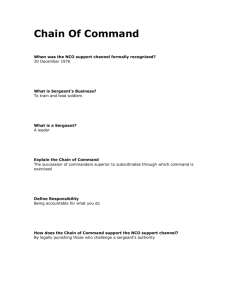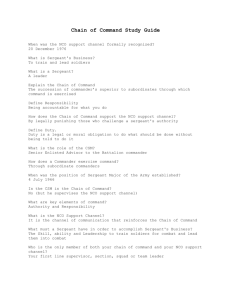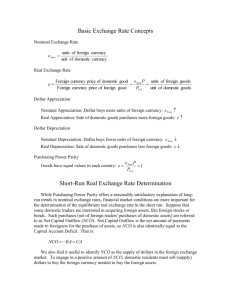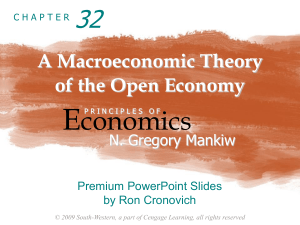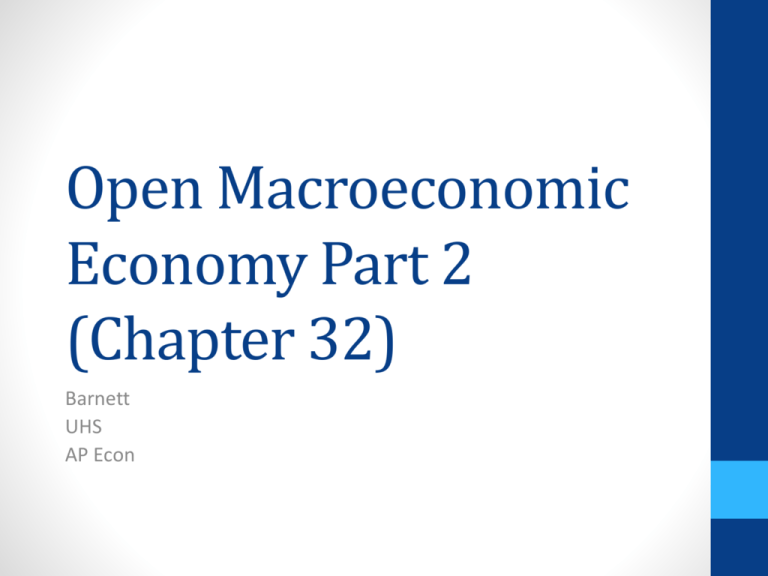
Open Macroeconomic
Economy Part 2
(Chapter 32)
Barnett
UHS
AP Econ
Introduction
• The previous chapter explained the basic concepts and vocabulary
of the open economy:
net exports (NX), net capital outflow (NCO),
and exchange rates.
• This chapter ties these concepts together into a theory of the open
economy.
• We will use this theory to see how govt policies and various events
affect the trade balance, exchange rate, and capital flows.
• We start with the loanable funds market…
The Market for Loanable Funds
• An identity from the preceding chapter:
S = I + NCO
Saving
Domestic
investment
Net capital
outflow
Supply of loanable funds = saving.
A dollar of saving can be used to finance
the purchase of domestic capital
the purchase of a foreign asset
So, demand for loanable funds = I + NCO
The Market for Loanable Funds
• Recall:
• S depends positively on the real interest rate, r.
• I depends negatively on r.
• What about NCO?
How NCO Depends on the Real Interest Rate
The real interest rate, r,
is the real return on
domestic assets.
A fall in r makes domestic
assets less attractive
relative to foreign assets.
• People in the U.S. purchase
more foreign assets.
• People abroad purchase
fewer U.S. assets.
• NCO rises.
r
Net capital outflow
r1
r2
NCO
NCO
NCO1
NCO2
The Loanable Funds Market Diagram
r adjusts to balance supply and
demand in the LF market.
r
Loanable funds
S = saving
Both I and NCO
depend negatively on r,
so the D curve is
downward-sloping.
r1
D = I + NCO
LF
ACTIVE LEARNING
1
Budget deficits and capital flows
• Suppose the government runs a budget deficit (previously, the
budget was balanced).
• Use the appropriate diagrams to determine
the effects on the real interest rate and
net capital outflow.
© 2012 Cengage Learning. All Rights Reserved. May not be copied, scanned, or duplicated, in whole or in part, except for use as
permitted in a license distributed with a certain product or service or otherwise on a password-protected website for classroom use.
ACTIVE LEARNING
Answers
1
When working with this model, keep in mind:
The
higher
r makes
U.S. saving
bonds and
morethe
attractive
relative
A budget
deficit
reduces
supply of
LF,
the LF market determines r (in left graph),
to
foreignr to
bonds,
causing
rise. reduces NCO.
then this value of r determines NCO (in right graph).
r
Loanable funds
S2
r
Net capital outflow
S1
r2
r2
r1
r1
D1
NCO1
LF
© 2012 Cengage Learning. All Rights Reserved. May not be copied, scanned, or duplicated, in whole or in part, except for use as
permitted in a license distributed with a certain product or service or otherwise on a password-protected website for classroom use.
NCO
The Market for Foreign-Currency Exchange
• Another identity from the preceding chapter:
NCO = NX
Net capital
outflow
Net exports
In the market for foreign-currency exchange,
NX is the demand for dollars:
Foreigners need dollars to buy U.S. net exports.
NCO is the supply of dollars:
U.S. residents sell dollars to obtain the foreign
currency they need to buy foreign assets.
The Market for Foreign-Currency Exchange
• Recall:
The U.S. real exchange rate (E) measures
the quantity of foreign goods & services
that trade for one unit of U.S. goods & services.
• E is the real value of a dollar in the market for foreign-currency
exchange.
The Market for Foreign-Currency Exchange
Anadjusts
increase
in E makes
E
to balance
U.S. goods
more
supply
and demand
E
expensive
to the
foreigners,
for
dollars in
reducesfor
foreign
demand
market
foreignfor U.S. goods—and
currency
exchange.
U.S. dollars.
E1
An increase in E
has no effect on
saving or investment,
so it does not affect
NCO or the supply of
dollars.
S = NCO
D = NX
Dollars
FYI: Disentangling Supply and Demand
When a U.S. resident buys imported goods,
does the transaction affect supply or demand
in the foreign exchange market? Two views:
1. The supply of dollars increases.
The person needs to sell her dollars to obtain the
foreign currency she needs to buy the imports.
2. The demand for dollars decreases.
The increase in imports reduces NX,
which we think of as the demand for dollars.
(So, NX is really the net demand for dollars.)
Both views are equivalent. For our purposes,
it’s more convenient to use the second.
FYI: Disentangling Supply and Demand
When a foreigner buys a U.S. asset,
does the transaction affect supply or demand
in the foreign exchange market? Two views:
1. The demand for dollars increases.
The foreigner needs dollars in order to purchase the
U.S. asset.
2. The supply of dollars falls.
The transaction reduces NCO, which we think of
as the supply of dollars.
(So, NCO is really the net supply of dollars.)
Again, both views are equivalent. We will use the second.
ACTIVE LEARNING
2
Budget deficit, exchange rate, and NX
• Initially, the government budget is balanced and trade is balanced
(NX = 0).
• Suppose the government runs a budget deficit. As we saw earlier, r
rises and NCO falls.
• How does the budget deficit affect the U.S. real exchange rate? The
balance of trade?
© 2012 Cengage Learning. All Rights Reserved. May not be copied, scanned, or duplicated, in whole or in part, except for use as
permitted in a license distributed with a certain product or service or otherwise on a password-protected website for classroom use.
ACTIVE LEARNING
Answers
2
The budget deficit
reduces NCO and the
supply of dollars.
Market for foreigncurrency exchange
S2 = NCO2
E
The real exchange
rate appreciates,
E2
reducing net exports.
E1
Since NX = 0 initially, the
budget deficit causes a
trade deficit (NX < 0).
S1 = NCO1
D = NX
Dollars
© 2012 Cengage Learning. All Rights Reserved. May not be copied, scanned, or duplicated, in whole or in part, except for use as
permitted in a license distributed with a certain product or service or otherwise on a password-protected website for classroom use.
The “Twin
Deficits”
Net exports and the budget deficit
often move in opposite directions.
6%
5%
U.S. federal
budget deficit
3%
2%
1%
0%
-1%
-2%
-3%
U.S. net exports
-4%
2006-2010
2001-2005
1996-2000
1991-95
1986-90
1981-85
1976-80
1971-75
1966-70
-5%
1961-65
Percent of GDP
4%
SUMMARY: The Effects of a Budget Deficit
• National saving falls
• The real interest rate rises
• Domestic investment and net capital outflow
both fall
• The real exchange rate appreciates
• Net exports fall (or, the trade deficit increases)
SUMMARY: The Effects of a Budget Deficit
• One other effect:
As foreigners acquire more domestic assets,
the country’s debt to the rest of the world increases.
• Due to many years of budget and trade deficits,
the U.S. is now the “world’s largest debtor nation.”
International Investment Position of the U.S.
31 December 2009
Value of U.S.-owned foreign assets
$18.4 trillion
Value of foreign-owned U.S. assets
$21.1 trillion
U.S.’ net debt to the rest of the world
$2.7 trillion
The Connection Between
Interest Rates
and Exchange Rates
r
r2
r1
Keepthat
in mind:
Anything
increases
r (not shown)
The
LF market
determines
will reduce
NCO r.
Thissupply
value of
and the
of r
then determines
NCO
dollars
in the foreign
(shown in upper
graph).
exchange
market.
This value of NCO then
Result:
determines supply of
The real exchange
dollars in foreign exchange
rate appreciates.
market (in lower graph).
NCO
NCO
NCO2
E
S2
NCO1
S1 = NCO1
E2
E1
D = NX
dollars
NCO2
NCO1
ACTIVE LEARNING
3
Investment incentives
• Suppose the government provides new
tax incentives to encourage investment.
• Use the appropriate diagrams to determine how this policy would
affect:
•
•
•
•
the real interest rate
net capital outflow
the real exchange rate
net exports
© 2012 Cengage Learning. All Rights Reserved. May not be copied, scanned, or duplicated, in whole or in part, except for use as
permitted in a license distributed with a certain product or service or otherwise on a password-protected website for classroom use.
ACTIVE LEARNING
Answers
3
rInvestment—and
rises,
the demand for LF—increase at each
causing
to fall.
value of NCO
r.
r
Loanable funds
Net capital outflow
r
S1
r2
r2
r1
r1
D1
D2
NCO
LF
NCO
NCO2
© 2012 Cengage Learning. All Rights Reserved. May not be copied, scanned, or duplicated, in whole or in part, except for use as
permitted in a license distributed with a certain product or service or otherwise on a password-protected website for classroom use.
NCO1
ACTIVE LEARNING
Answers
The fall in NCO reduces
the
supply of dollars
in the foreign exchange
market.
The real exchange
rate appreciates,
3
Market for foreigncurrency exchange
S2 = NCO2
E
S1 = NCO1
E2
E1
reducing net exports.
D = NX
Dollars
© 2012 Cengage Learning. All Rights Reserved. May not be copied, scanned, or duplicated, in whole or in part, except for use as
permitted in a license distributed with a certain product or service or otherwise on a password-protected website for classroom use.
Budget Deficit vs. Investment Incentives
• A tax incentive for investment has similar effects as a budget deficit:
• r rises, NCO falls
• E rises, NX falls
• But one important difference:
• Investment tax incentive increases investment, which increases
productivity growth and living standards in the long run.
• Budget deficit reduces investment,
which reduces productivity growth and living standards.
Trade Policy
• Trade policy:
a govt policy that directly influences the quantity of g&s
that a country imports or exports
• Examples:
• Tariff – a tax on imports
• Import quota – a limit on the quantity of imports
• “Voluntary export restrictions” – the govt pressures another country to
restrict its exports; essentially the same as an import quota
Trade Policy
• Common reasons for policies that restrict imports:
• Save jobs in a domestic industry that has difficulty competing with
imports
• Reduce the trade deficit
• Do such trade policies accomplish these goals?
• Let’s use our model to analyze the effects of
an import quota on cars from Japan
designed to save jobs in the U.S. auto industry.
Analysis of a Quota on Cars from Japan
An import quota does not affect saving or investment,
so it does not affect NCO. (Recall: NCO = S – I.)
r
Loanable funds
r
Net capital outflow
S
r1
r1
D
NCO
LF
NCO
Analysis of a Quota on Cars from Japan
Since NCO unchanged, S
curve does not shift.
The D curve shifts:
At each E,
imports of cars fall,
so net exports rise,
D shifts to the right.
At E1, there is excess
demand in the foreign
exchange market.
E rises to restore eq’m.
Market for foreigncurrency exchange
E
S = NCO
E2
E1
D2
D1
Dollars
Analysis of a Quota on Cars from Japan
What happens to NX? Nothing!
• If E could remain at E1, NX would rise, and the quantity of dollars
demanded would rise.
• But the import quota does not affect NCO,
so the quantity of dollars supplied is fixed.
• Since NX must equal NCO, E must rise enough to keep NX at its
original level.
• Hence, the policy of restricting imports
does not reduce the trade deficit.
Analysis of a Quota on Cars from Japan
Does the policy save jobs?
The quota reduces imports of Japanese autos.
• U.S. consumers buy more U.S. autos.
• U.S. automakers hire more workers to produce these extra cars.
• So the policy saves jobs in the U.S. auto industry.
But E rises, reducing foreign demand for U.S. exports.
• Export industries contract, exporting firms lay off workers.
The import quota saves jobs in the auto industry
but destroys jobs in U.S. export industries!!
CASE STUDY: Capital Flows from China
• In recent years, China has accumulated U.S. assets to
reduce its exchange rate and boost its exports.
• Results in U.S.:
• Appreciation of $ relative to Chinese renminbi
• Higher U.S. imports from China
• Larger U.S. trade deficit
• Some U.S. politicians want China to stop,
argue for restricting trade with China to protect
some U.S. industries.
• Yet, U.S. consumers benefit
Political Instability and Capital Flight
• 1994: Political instability in Mexico made world financial markets
nervous.
• People worried about the safety of Mexican assets they owned.
• People sold many of these assets, pulled their capital out of Mexico.
• Capital flight: a large and sudden reduction in the demand for
assets located in a country
• We analyze this using our model, but from the perspective of
Mexico, not the U.S.
Capital Flight from Mexico
Demand
The
equilibrium
forinvestors
LF =values
I + sell
NCO.
oftheir
r and
NCOand
bothpull
increase.
As foreign
assets
out their
The
increase
in NCO increases
demand
capital,
NCO increases
at each value
of r.for LF.
r
Loanable funds
r
Net capital outflow
S1
r2
r2
r1
r1
D1
D2
NCO2
NCO1
LF
NCO
Capital Flight from Mexico
The increase in NCO
causes an increase in the
supply of pesos in the
foreign exchange market.
The real exchange rate
value of the peso falls.
Market for foreigncurrency exchange
E
S1 = NCO1
S2 = NCO2
E1
E2
D1
Pesos
4/1/1995
3/12/1995
2/20/1995
1/31/1995
1/11/1995
12/22/1994
12/2/1994
11/12/1994
10/23/1994
US Dollars per currency unit .
Examples of Capital Flight: Mexico, 1994
0.35
0.30
0.25
0.20
0.15
0.10
7/19/1998
100
4/25/1998
120
1/30/1998
11/6/1997
8/13/1997
5/20/1997
2/24/1997
12/1/1996
1/1/1997 = 100
US Dollars per currency unit.
Examples of Capital Flight: S.E. Asia, 1997
South Korea Won
Thai Baht
Indonesia Rupiah
80
60
40
20
0
12/31/1998
11/21/1998
10/12/1998
9/2/1998
7/24/1998
6/14/1998
5/5/1998
US Dollars per currency unit .
Examples of Capital Flight: Russia, 1998
0.20
0.16
0.12
0.08
0.04
0.00
1/12/2003
10/24/2002
8/5/2002
5/17/2002
2/26/2002
12/8/2001
9/19/2001
7/1/2001
U.S. Dollars per currency unit .
Examples of Capital Flight: Argentina, 2002
1.2
1.0
0.8
0.6
0.4
0.2
0.0

